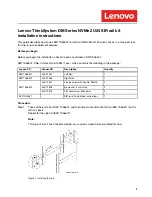
Circuit Descriptions, Abbreviation List, And IC Data Sheets
9.
9.
Circuit Descriptions, Abbreviation List, And IC Data Sheets
Index of this chapter:
9.1 Introduction
9.2 Abbreviation List
Note:
Only
new
(not recently published) circuits are described here.
As this chassis does not contain any really new circuits, use the
FTL2.2x manual for the circuit descriptions.
9.1
Introduction
This chassis contains, compared to its predecessor, the
following
new/changed
features/components:
•
Small Signal Board
(SSB). Small layout changes and new
software to support the 720p feature.
•
Dual Ambient Light inverter panels
: To reduce the heat
dissipation and improve the efficiency, two separate CCFL
inverter panels are introduced in some models.
•
Dimming Backlight
: Feature to improve the contrast of
LCD displays. When there is no (or little) white content in
the picture, the LCD backlight will be dimmed to make the
black look darker. The picture content is measured by the
EPLD, which will adapt the PWM signal to the backlight
(see also diagrams B19E and B20).
The chassis consists of a full sized SSB, two Power Supplies
(Main and Stand-by), and some smaller panels for Audio, I/O,
and Control functions. The main functionalities are:
•
LCD power supply
: same as used in the FTL2.2x.
•
SSB
: Core TV functionalities, being TXT/control, video and
audio decoding, feature box, video featuring, and sync/
geometry control. The SSB is a high tech module (four
layer, 2 sides reflow technology, full SMC) with very high
component density and full shielding for EMC-reasons.
Despite this, it is designed in such a way, that repair on
component level is possible. To achieve this, attention was
paid to:
–
Clearance around surface mounted ICs (for replacing).
–
Detailed diagnostics and fault finding is possible via
ComPair.
–
Software upgrading (only for main software) is possible
via ComPair.
9.2
Abbreviation List
1080i
1080 visible lines, interlaced
1080p
1080 visible lines, progressive scan
2DNR
Spatial (2D) Noise Reduction
3DNR
Temporal (3D) Noise Reduction
AARA
Automatic Aspect Ratio Adaptation:
algorithm that adapts aspect ratio to
remove horizontal black bars; keeping
up the original aspect ratio
ACI
Automatic Channel Installation:
algorithm that installs TV sets directly
from cable network by means of a
predefined TXT page
ADC
Analogue to Digital Converter
AFC
Automatic Frequency Control: control
signal used to tune to the correct
frequency
AGC
Automatic Gain Control: algorithm that
controls the video input of the feature-
box
AM
Amplitude Modulation
ANR
Automatic Noise Reduction: one of the
algorithms of Auto TV
AR
Aspect Ratio: 4 by 3 or 16 by 9
Artistic
See OTC 2.5: main processor
ASF
Auto Screen Fit: algorithm that adapts
aspect ratio to remove horizontal black
bars but without throwing away video
information
ATV
See Auto TV
AUDIO_C
Audio Centre
AUDIO_L
Audio Left
AUDIO_R
Audio Right
AUDIO_SL
Audio Surround Left
AUDIO-SR
Audio surround right
AUDIO_SW
Audio Sub woofer
Auto TV
A hardware and software control
system that measures picture content,
and adapts image parameters in a
dynamic way
B/G
Monochrome TV system. Sound
carrier distance is 5.5 MHz. B= VHF-
band, G= UHF-band
B-SC1-IN
Blue SCART1 in
B-SC2-IN
Blue SCART2 in
B-TXT
Blue teletext
CL
Constant Level: audio output to
connect with an external amplifier
ComPair
Computer aided rePair
CSM
Customer Service Mode
CTI
Colour Transient Improvement:
manipulates steepness of chroma
transients
CVBS
Composite Video Blanking and
Synchronisation
CVBS-TER
CVBS terrestrial
COLUMBUS
COLour LUMinance Baseband
Universal Subsystem. IC performing
noise reduction and 2D/3D comb
filtering
DAC
Digital to Analogue Converter
DBE
Dynamic Bass Enhancement: extra
low frequency amplification
DDC
Display Data Channel; is a part of the
"Plug and Play" feature
DFU
Direction For Use: description for the
end user
D/K
Monochrome TV system. Sound
carrier distance is 6.5 MHz. D= VHF-
band, K= UHF-band
www.freeservicemanuals.info
17/6/2013
World of free manuals
















































